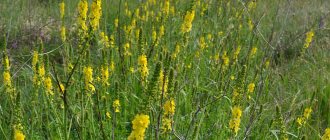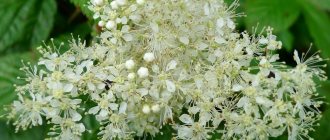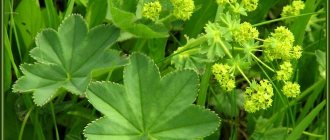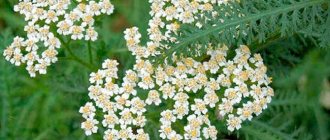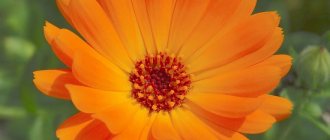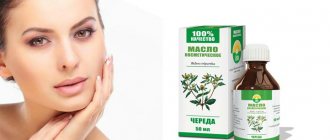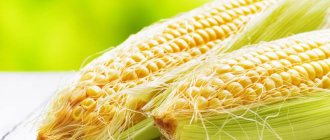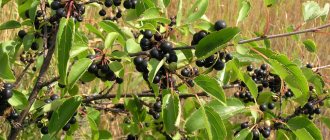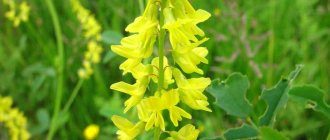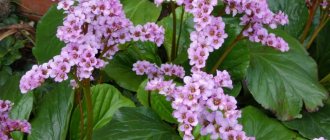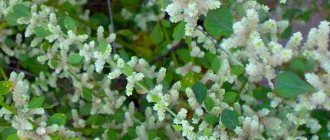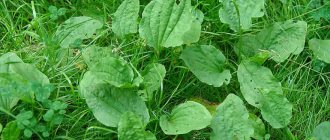People have come up with many names for knotweed: bird knotweed, murava, bird buckwheat, goose grass, ostudnik, hernia grass, trampling grass, goose grass.
It received its most common name for its ability to quickly, “quickly” grow back after damage and mowing.
Appearance
Every villager knows from childhood what knotweed grass looks like. This is an annual plant up to 60 cm tall, but usually spreads along the ground, so it is perceived as shorter.
The stem is highly branched, with pronounced nodes, and becomes hard after flowering. The leaves are small, elliptical or oblong.
In spring, the leaves have a soft emerald hue, in summer they become dark green with a grayish tint, and by autumn they become ocher. Very small white or pink flowers sit in the axils of the leaves.
It blooms all summer and half of autumn, the peak of flowering depends on the area, on average it occurs in July.
The fruit is a small nut with three sides from brown to black. You will probably remember knotweed grass if you look at the photo.
Places of growth
In the territory of the former USSR, the knotweed grows everywhere except the Arctic.
Most often it can be found in meadows, wastelands, banks of reservoirs, near roads and residential buildings. It is undemanding to soil composition and moisture conditions, and can even grow on clay and gravel.
Where does the knotweed grow?
Knotweed is widespread in Eurasia and North America. In Russia it can be found everywhere except the northernmost corners of the country and high mountain regions.
Knotweed is an unpretentious weed; it is a common plant in vacant lots, village streets, lawns near houses, along roads. This weed can settle in vegetable gardens and orchards, but people have never considered it a malicious weed. Among the people, knotweed has firmly established itself as a good medicinal plant.
Polygonum herbs are a whole complex of dozens of species and subspecies that are difficult to distinguish even for botanists. But in medicinal terms, all types are the same and when preparing raw materials they are not distinguished.
Knotweed improves appetite and helps you gain weight. It has been noticed that geese that graze for a long time on knotweed quickly become fat. This is where another popular name for the plant came from: gossamer.
Uses of knotweed
A little about the use of knotweed herb. Previously, dyes were made from this plant: various warm colors were produced from the above-ground part, and blue paint was produced from the underground part.
Ant is excellent for livestock feed; birds especially love it, which is reflected in some variations of the name.
Greens are added to soups at the end of cooking so that the knotweed herb retains its beneficial properties.
The use of knotweed in folk medicine
In folk medicine, knotweed is used in the form of infusions, decoction, powder and fresh juice during the flowering period of the plant.
- Infusions treat gastritis, stomach and duodenal ulcers, liver, kidney, and bladder diseases.
- The infusion can be drunk to improve metabolism, for all types of pulmonary diseases and even for tuberculosis.
- Polygonum preparations help get rid of sand in the kidneys and bladder.
- You can wash your hair with a decoction of the herb for better hair growth.
- Wounds and bruises can be treated with compresses from an infusion of fresh herbs, or by applying fresh leaves to the site of the bruise.
- A hot infusion of knotweed herb can be used to steam swollen and tired legs from long walking.
In the old days, fear in children was relieved by bathing in a herbal decoction, and a freshly boiled chicken egg was placed under the pillow. This procedure was repeated three evenings in a row.
Contraindications and precautions
Despite recommendations for using knotweed herb to increase the likelihood of conception, you should not drink it during pregnancy, as it increases the tone of the uterus, which creates a risk of miscarriage.
- Lyubka bifolia - medicinal properties and the best recipes from traditional medicine (110 photos)
- Jaundice - description of the plant, medicinal properties and features of use in folk medicine (80 photos)
Field thistle - medicinal properties, recipes, uses and contraindications of thistle (video + photo)
This medicine is not suitable for hypotensive patients either, because it lowers blood pressure. It can also be harmful in acute kidney diseases.
Herbal medicine, like any treatment, requires prior consultation with a doctor. A specialist will help you figure out whether you have contraindications to the use of knotweed herb.
Medicinal properties of knotweed
The grass is so popular that it is used not only in Russia. Knotweed is used for treatment in Tibet, China and Korea.
The entire above-ground part of the plant is used for medicinal purposes. Knotweed is completely non-toxic to humans and poses no danger. The chemical properties of knotweed herb have been well studied: it contains a lot of silicic acid and tannins.
In the aerial part of the plant, the glycoside avicularin, resins, essential oil, ascorbic acid, carbohydrates, proteins, zinc, phosphorus, and calcium salts were found. Dry leaves contain up to 40 mg% carotene. The glycoside is avicular, used in the treatment of whooping cough.
- Scientific medicine uses knotweed as a hemostatic, diuretic and astringent. An infusion of knotweed reduces blood pressure and improves lung function.
- In a hospital setting, knotweed infusion and decoction are prescribed for uterine bleeding in the postpartum period. Plant-based preparations enhance contraction of the uterine muscles and help stop bleeding.
- The grass of the knotweed is included in the mixture according to the recipe of M.N. Zdrenko and is used for papillomatosis of the bladder and anacid gastritis.
- Knotweed is used in the treatment of pulmonary diseases and as an astringent.
- In scientific medicine, an infusion of knotweed herb is used as a means of promoting the removal of stones in urolithiasis.
- The antispasmodic effect of knotweed has been established.
Self-harvesting knotweed
Bird knotweed is stored during flowering. The top 30 cm of shoots need to be mowed or cut off, leaving the lower hard part.
Contaminated areas and pastures are not suitable for harvesting medicinal raw materials. The farther the collection site is from roads and industrial enterprises, the better.
The cut parts of the plants are laid out in a thin layer in a warm, shaded place and dried until brittle, turning over periodically.
Store dried knotweed in fabric bags or jars with a ventilated lid for up to 3 years. Stocks of nondescript ants will come to the rescue in case of illness.
Traditional medicine recipes
- To prepare a simple infusion, the herb should be crushed, pour boiling water in a ratio of 1/10 and place in a boiling water bath for 10 minutes. Then remove the infusion from the heat, cool, let it brew for an hour, strain. Take one tablespoon three to four times a day.
Treatment of anemia with knotweed
- In case of anemia from blood loss, pour one tablespoon of the whole plant with a glass of boiling water and leave for two hours. Take 100 ml of infusion 3 times a day before meals.
Bath for the treatment of arthritis
- To treat arthritis, you can use an infusion: pour 300 grams of herb into five liters of boiling water. Let it brew for two hours, strain and pour into the bath. The water temperature should be between 32 and 34 °C. Take a bath every other day, the duration of the procedure is 20 minutes.
Knotweed for the treatment of hypertension
- Prepare an infusion: pour 20 grams of dry and crushed herbs into one glass of boiling water. Let it brew for 15 minutes, strain, and take a tablespoon three times a day for hypertension.
Treatment of skin diseases and allergic diathesis
- Prepare a decoction: pour 20 grams of herb with a glass of water, put on fire and boil for 10 minutes. Remove from heat and strain. Use the infusion for lotions, washes and applications for skin diseases and diathesis.
Knotweed against diarrhea
- Pour three teaspoons of fresh knotweed herb into two glasses of boiling water. Let it brew for four hours. For diarrhea, take 1/2 cup 4 times a day before meals.
Cough treatment
- To treat cough and whooping cough, you can take an infusion: brew 20 grams of herb with a glass of boiling water. Let it brew for one hour, strain. Take a tablespoon 2-3 times a day.
Infusion for treating bruises
- Knit 40 grams of dry grass, brew with a glass of boiling water for half an hour. Strain and use for lotions and compresses for injuries and bruises.
Infusion for gum inflammation
- This infusion can also be used for applications and mouth rinses for stomatitis. Infusion: pour 20 grams of dry herb with a glass of boiling water, leave for half an hour.
Photo of knotweed grass
Read here! Snake knotweed - description, recipes, use, properties and contraindications for use (105 photos)
Please repost
0
